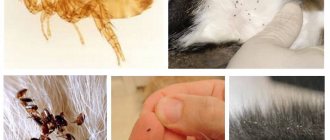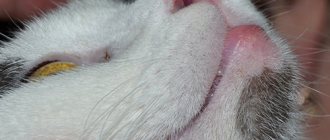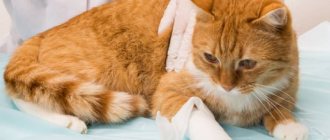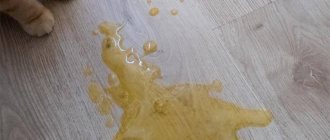Pet owners often face the problem of parasites in their pets. One of the most common species is fleas. First of all, they appear in cats whose owners allow them to walk outside.
Pet owners often face the problem of parasites in their pets. One of the most common species is fleas. First of all, they appear in cats whose owners allow them to walk outside. The appearance of fleas negatively affects the well-being and mood of the pet. In addition to discomfort, small creatures can cause harm to the health of both the animal itself and the people around it. Despite the fact that fleas do not cause infectious diseases in cats, when they live on the body for a long time, they contribute to the development of anemia and weakened immunity. This condition leads to the inevitable development of all kinds of diseases. In such a situation, it is important for the animal owner to know how to detect the presence of parasites in order to promptly take effective measures to destroy them.
Appearance of the parasite
To find out if a cat has fleas, you need to know the parasite in person. The most common pest of cats is fleas of the species Ctenocephalides felis.
The insects are small in size - about 3 mm in length. They have an elongated body shape, flattened laterally. The hind limbs are somewhat longer, so the end of the back is raised towards the top. The body is dark brown.
On a note!
Fleas are extremely active, crawl quickly, jump well in height and length, and are difficult to catch. Parasites do not live on a cat’s body; they crawl into it to feed. Therefore, it is possible to determine that a cat has fleas based on indirect evidence.
The larvae differ in appearance from adults, lead a different lifestyle, feed on food waste, rot, and dead particles of the epidermis. You can find them under the rug, in the pet’s sleeping place, near its toilet. They look like small off-white worms.
Flea eggs do not exceed 0.5 mm. Females literally shoot them away from themselves. They can only be detected if a room or individual area is heavily infested. They look like grains of sand. Rarely found in animal fur.
Wet paper test
After examining the pet's fur and skin, the owner may doubt the results without noticing a single insect. But if the cat continues to itch, you can do a test with a white sheet of paper.
First, a sheet of paper over which the animal will comb its comb can be moistened with a spray bottle.
When you brush a cat that has been bitten by fleas, small black-brown crumbs will begin to fall onto the white paper. This is flea feces. The fact that when it comes into contact with wet paper, excrement leaves a reddish tint helps confirm the guess. This is nothing more than the remains of the blood that the insect fed on.
This test should be carried out if no fleas were found during examination of the adult individuals themselves.
Symptoms of infection by behavior
You can identify fleas in a cat by its behavior. Insects cause a lot of inconvenience, pain, and affect the well-being of the pet. Fleas in a kitten lead to delayed growth and development. In case of severe infection, it leads to death.
Insects bite painfully, the cat reacts to bites with plaintive meows, sudden jumps, or digs its teeth into the fur and tries to get something. The stronger the infection, the more restless the cat.
- Sleep is disturbed, the pet constantly shudders, moves its whiskers, ears, and groans.
- During the day she cannot sit in one place for a long time, periodically jumps up, jumps, tries to climb somewhere, in the hope that the parasites will not get her there.
- It itches constantly, digs its teeth into the fur, tears the skin with its claws, and pulls out the fur with its teeth.
- Appetite spoils.
It is impossible not to replace such changes. But even if there is not enough such evidence, you should pay attention to the appearance of the pet.
Intradermal allergy test for flea saliva
The third type of research should be carried out in laboratory conditions. Before prescribing an intradermal allergy test for flea saliva, the veterinarian will conduct a general clinical examination of the cat and collect an anamnesis. A specific study may be necessary if the cat has developed flea dermatitis, which is an allergic reaction to the saliva of blood-sucking insects, but there are no fleas themselves.
In a clinical setting, the doctor gives the cat an allegotest. To do this, allergens are administered subcutaneously to determine the body's sensitivity to certain substances. Based on the data obtained, the specialist develops treatment tactics.
Symptoms of infection by appearance
Signs of the presence of fleas
Lack of appetite, poor sleep, scratching, and constant nervous tension cannot but affect the appearance of the cat. The fur stops shining, and places where it is missing appear. The cat looks sloppy and dirty because parasite excrement remains on the hairs.
Important!
When an animal is severely infected, it rapidly loses weight and begins to get sick. If you don't take emergency measures, everything could end in the death of your pet.
What can be confused with fleas
Indirect signs (black spots on the fur, redness and swelling on the skin) do not always indicate the presence of fleas. The reason for their appearance may be:
- acne is inflammation of the sebaceous glands. Black spots appear on the chin and face that look like flea feces;
- injuries and allergic reactions;
- other arthropods - cats are affected by small ticks, lice and lice.
It is important to understand the cause before treatment. Fleas and other parasites are killed by complex agents that disrupt the functions of the nervous system of arthropods and prevent the development of larvae. For injuries, inflammation and internal pathologies, other remedies are required.
Examination of the animal
You can easily find fleas on a cat if there is a severe infestation. Just move the fur aside and take a closer look. Small insects that move quickly will be found in the undercoat layer. Even if they are not there, fleas can be recognized by indirect evidence.
- On the body there are wounds from bites, scratches, scratches from teeth, claws. Cat fleas bite painfully, so the animal immediately digs its teeth into the affected area or tries to scratch it with its paw. Such actions further damage the skin.
- The bites leave a strong itch, which causes the cat to scratch constantly. A secondary infection penetrates into the wounds, pustules, ulcers, irritation, and inflamed areas form on the body.
- You can detect fleas on a cat by looking at the excrement of the parasites. They remain on the fur in the form of small grains of dark sand. Well visible on light coats.
Blood test for immunoglobulins E to flea saliva
Sometimes it only takes one flea bite for a cat to develop an allergic reaction. A specific reaction can develop even if a cat is bitten by a flea while walking on the street or accidentally gets into the house. Pedigree cats are especially at risk of developing flea dermatitis. An allergy in an animal develops as a result of a specific reaction of the body to the saliva of a flea.
The fact is that fleas, before starting to feed on blood, bite through the skin, secreting a small amount of a specific secretion into the dermis. This saliva contains about 14 foreign protein components that can cause irritation or allergies.
In one home with several cats, one may develop flea dermatitis, while others will not have any symptoms of the pathological process.
It depends on the individual characteristics and hypersensitivity of the body. Sometimes, owners notice that their pet develops seasonal baldness - the appearance of hairless areas. This may indicate hypersensitivity to the bites of blood-sucking insects, namely fleas.
It is worth noting that intradermal testing has been used in veterinary practice for quite a long time. But recently, ELISA diagnostic tests have been used. They make it possible to determine the concentration of specific immunoglobulins E in the bloodstream.
Infections transmitted through fleas
These parasites are quite dangerous for animals in that they can be carriers of such dangerous diseases as hemobartonosis of cats and dipylidiasis of carnivores.
Hemobartonosis is a disease caused by mycoplasmas, also known as feline infectious anemia. Mycoplasmas cause massive death of erythrocytes (red blood cells), which leads to severe anemia and hypoxia, as a result of which the cat can even die!
Dipylidia is a parasitic disease caused by the tapeworm, also known as the cucumber tapeworm because its segments resemble cucumber seeds.
Adult dipylidia live in the small intestine, causing gastrointestinal dysfunction (diarrhea, abdominal pain, etc.) in the host.
Dogs and cats become infected through a flea bite. There are only two diseases in humans caused by the bites of these insects: pulicosis and sarcopsylosis . In addition, bites can transmit more than twenty infections dangerous to humans, including the bubonic plague, which killed half of Europe in the Middle Ages.
Cat diseases carried by fleas
Not only are fleas dangerous because they itch and burn, but fleas also transmit several diseases that can have a detrimental effect on your cat's health.
- Anemia : Flea infestation can cause anemia due to blood loss; it can sometimes be fatal, especially in kittens. Pale gums are a symptom of anemia in kittens and a sign that immediate veterinary attention is required.
- Tapeworms : Fleas can also carry parasites.
- Hemobartonellosis (Mycoplasma Haemofelis) : Fleas can also carry a blood parasite called Mycoplasma Haemofelis. This bacterium can cause anemia, fever and severe illness. Hemobartonellosis is diagnosed through laboratory tests and treated with antibiotics and, in some severe cases, blood transfusions.
How to rid a cat of parasites
Fleas not only cause discomfort to animals and humans, they bite painfully. They carry dozens of deadly diseases and helminth eggs. Fleas can cause weakness and anemia in a kitten. If parasites are found on an animal, flea extermination should be started immediately. In addition to caring for the pet itself, you will need to disinfest the apartment and carefully treat all its belongings, toys, cat house, and accessories.
The choice of means of exterminating and protecting cats from fleas is huge. When choosing a drug for your pet, you should be guided by the age of the animal, ease of use of the product, toxicity and effectiveness of the drug. Arsenal of anti-flea products:
- Antiparasitic shampoos. Conventionally, they are divided into detergents for killing fleas and repelling them. The former contains an insecticide that has a destructive effect on parasites. The product is applied to the cat’s wet skin, left for several minutes, and then washed off. A single treatment is sufficient to kill fleas. Popular detergents are “Bio Groom”, Lugovoi, “Clandestine”, Bars, “Fitoelita”.
Flea shampoos - Drops on the withers for cats have a destructive effect and protect the cat from parasites for 2-3 months, depending on the manufacturer. The drops are incredibly easy to use. It is enough to remove the pipette with drops from the packaging and apply the product to the animal’s withers. The death of parasites occurs within 24 hours after application. According to consumer reviews, the following drops have proven themselves well: four with a tail, Frontline, Delix, Rolf Club 3d, Barrier, Dana Ultra Neo, Stronghold, Advantage, Blochnet, Celandine, Helmintal, Inspector.
- Collars for cats to kill insects have the greatest effect if you first bathe the cat with anti-flea shampoo. The following collars are in demand among cat owners: Bars, Celandine, Beafar and others.
- Anti-parasite spray for cats destroys pests and provides long-term protection for your pet from blood-sucking insects. The product is applied to dry skin against hair growth. To prevent the pet from licking the drug, a protective collar is put on it. You cannot bathe your cat 2 days before the procedure and 2 days after.
It is imperative to get rid of fleas. They are dangerous not only for a domestic friend, but also for humans.
How does a cat get fleas if he doesn't go outside?
A cat can easily become infected with fleas. She doesn't have to walk outside to do this. Infection can occur:
- upon contact with stray animals (cats, dogs, birds), if they get into the house, or with other pets, if they go outside, for example, a dog, or new pets;
- when visiting a veterinary clinic;
- through a person’s shoes and clothing;
- insects can themselves enter the house (entrance, balcony, etc.);
- in contact with rodents (mice, rats).
Also read the article about why even a domestic cat can have fleas and what to do in this case.
Flea eggs and larvae - how to effectively get rid of them
The fight against fleas is not limited to the destruction of parasites that live on the cat. The environment in which an infested animal lives includes flea eggs and larvae, as well as adult insects. Linen on which the cat sleeps or simply rests frequently should be washed at the hottest temperature possible.
It is worth vacuuming your apartment more often - this will help get rid of eggs, larvae and pupae. Small surfaces, such as armchairs or chairs on which the cat sits, can be further treated with a hair roller. Parasites that were not absorbed by the vacuum cleaner may stick to it.
Additional preparations for killing environmental insects at all stages of development are also very useful in the fight against fleas, but you should choose only those that are completely safe.
For example, medications containing dimethicone cause eggs to stick together and paralyze fleas and their larvae.
There are also electric flea traps that are installed at night near the place where the cat sleeps. However, these devices are quite expensive. An alternative could be a homemade trap in the form of a plate with warm water and soap (the heat attracts fleas, and then they will simply drown in the foam).
How do they reproduce?
On cats, these insects reproduce very quickly, and only a few days are enough for the animal to be completely “occupied” by reptiles .
Like all blood-sucking creatures of this type, fleas lay small eggs on the animal’s hair.
It is worth mentioning that eggs can only be laid by a well-fed female who has been parasitizing the pet for some time. The clutch can be of different sizes: it all depends on the conditions, the condition of the parasite and the environment.
Detecting eggs is quite difficult : this will require special equipment, because the size of future parasites is very small.
After 1-4 days, pupae hatch from the eggs, which develop into worms that feed on the skin of the animal, excrement of mature individuals, litter, etc. After 1 - 3 weeks, the pupa turns into a full-fledged individual, which can be seen on the cat.
Study the article about flea drops for cats, as well as reviews of some brands: Stronghold, Advocate, Advantage, Inspector, Bars, Frontline.
How dangerous are fleas on a cat?
It is important to pay attention to the behavior of the animal in order to detect the disease in time. Insects reproduce quickly: one female is capable of laying more than 100 eggs per day.
Fleas are also dangerous for the diseases they carry: helminthiasis, toxoplasmosis, rickettsiosis, etc. In addition, insect bites become inflamed and serve as a reason for the development of infection. Many animals suffer from allergies to insect bites - flea allergy dermatitis. In this case, fleas will cause an increase in temperature and, in the worst case scenario, cause the death of the pet.
If you notice the first signs of fleas in your cat, contact your veterinarian, who will confirm with 100% accuracy the presence of an infestation and help you choose the right treatment.
Preventative measures against re-infection
In order to detect parasites on the body in time and quickly get rid of them, you need to inspect the animal’s skin more often, carefully parting the fur. If your cat enjoys bathing, you should use a flea treatment instead of regular shampoo. And, of course, regular wet cleaning of the house.
This is quite enough if the cat does not go outside. But with a free lifestyle, it is still recommended to use special means from the described arsenal.
Prevention and treatment
If the owner has discovered that the pet has been attacked by fleas, it is worth immediately taking measures to eliminate the parasites. They are quite prolific. The sooner you start treating an animal, the fewer of them will breed in the future.
- Choose the right product.
Modern drugs are quite effective and safe for animals. They are sold in veterinary pharmacies, most of them are available without a prescription. It is important to choose products specifically for cats, as some drugs for dogs can have a negative effect on the body of other pets. Zoo shampoo "Four with a tail" contains only repellent ingredients and is therefore safe for cats. - Treat your animal regularly.
In this case, follow the instructions for the product and the doctor’s recommendations. This way you can protect your pet from parasites and save him from possible problems in the future. If treatment resolves the unpleasant symptoms, then they were caused by fleas, even if you could not detect them. - Choose a suitable collar.
A repellent collar repels parasites and makes the animal's odor unattractive to them. The product is a porous tape with an applied active substance. For example, the repellent collar “Four with a tail” contains essential oils and is used to protect against lice, fleas, mosquitoes, lice, scabies and ixodid ticks. A repellent collar can help prevent fleas from reinfecting your pet. - Protect your home from fleas.
Eggs and pupae of parasites can remain alive for up to several months. Therefore, treat your home with special products intended for indoor use. Vacuum upholstered furniture and carpets daily. If the infestation is severe, consider calling a pest control service.











